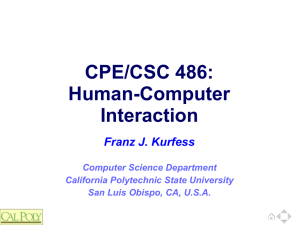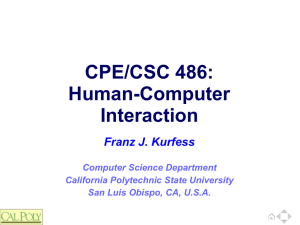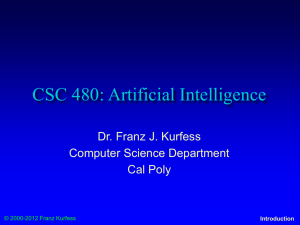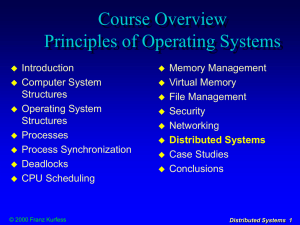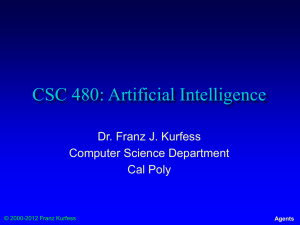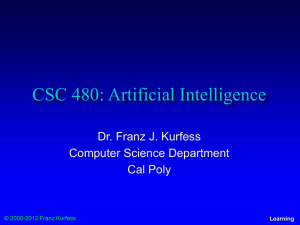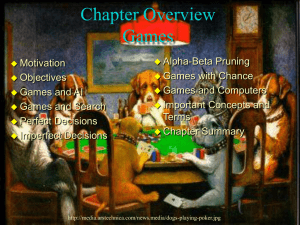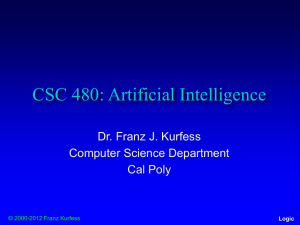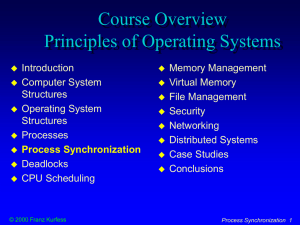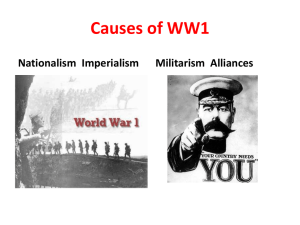3-Knowledge-Representation
advertisement
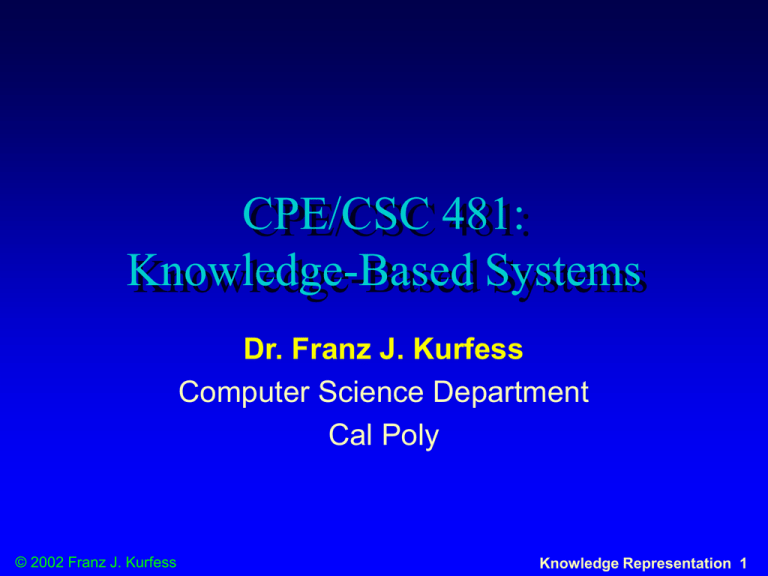
CPE/CSC 481: Knowledge-Based Systems Dr. Franz J. Kurfess Computer Science Department Cal Poly © 2002 Franz J. Kurfess Knowledge Representation 1 Course Overview Introduction CLIPS Overview Representation Semantic Nets, Frames, Logic Reasoning and Inference Predicate Logic, Inference Methods, Resolution Reasoning Concepts, Notation, Usage Knowledge Pattern with Uncertainty Variables, Functions, Expressions, Constraints Expert Matching System Design ES Life Cycle Expert System Implementation Salience, Rete Algorithm Expert System Examples Conclusions and Outlook Probability, Bayesian Decision Making © 2002 Franz J. Kurfess Knowledge Representation 2 Overview Knowledge Representation Motivation Knowledge Objectives Methods Chapter Introduction Review of relevant concepts Overview new topics Terminology Knowledge and its Meaning Epistemology Types of Knowledge Knowledge Pyramid © 2002 Franz J. Kurfess Representation Production Rules Semantic Nets Schemata and Frames Logic Important Concepts and Terms Chapter Summary Knowledge Representation 3 Logistics Term Project Lab and Homework Assignments Exams Grading © 2002 Franz J. Kurfess Knowledge Representation 4 Bridge-In © 2002 Franz J. Kurfess Knowledge Representation 5 Pre-Test © 2002 Franz J. Kurfess Knowledge Representation 6 Motivation KBS are useless without the ability to represent knowledge different knowledge representation schemes may be appropriate depending on tasks and circumstances knowledge representation schemes and reasoning methods must be coordinated © 2002 Franz J. Kurfess Knowledge Representation 7 Objectives know the basic principles and concepts for knowledge representation knowledge - information - data meaning be familiar with the most frequently used knowledge representation methods logic, rules, semantic nets, schemata differences between methods, advantages, disadvantages, performance, typical scenarios understand the relationship between knowledge representation and reasoning syntax, semantics derivation, entailment apply knowledge representation methods usage of the methods for simple problems © 2002 Franz J. Kurfess Knowledge Representation 8 Knowledge and its Meaning Epistemology Types of Knowledge Knowledge Pyramid © 2002 Franz J. Kurfess Knowledge Representation 10 Epistemology the science of knowledge EPISTEMOLOGY ( Gr. episteme, "knowledge"; logos, "theory"), branch of philosophy concerned with the theory of knowledge. The main problems with which epistemology is concerned are the definition of knowledge and related concepts, the sources and criteria of knowledge, the kinds of knowledge possible and the degree to which each is certain, and the exact relation between the one who knows and the object known. [Infopedia 1996] © 2002 Franz J. Kurfess Knowledge Representation 11 Knowledge Definitions knowlaedge \'nS-lij\ n [ME knowlege, fr. knowlechen to acknowledge, irreg. fr. knowen ] (14c) 1 obs : cognizance 2a (1) : the fact or condition of knowing something with familiarity gained through experience or association (2) : acquaintance with or understanding of a science, art, or technique b (1) : the fact or condition of being aware of something (2) : the range of one's information or understanding <answered to the best of my 4> c : the circumstance or condition of apprehending truth or fact through reasoning : cognition d : the fact or condition of having information or of being learned <a man of unusual 4> 3 archaic : sexual intercourse 4 a : the sum of what is known : the body of truth, information, and principles acquired by mankind b archaic : a branch of learning syn knowledge, learning, erudition, scholarship mean what is or can be known by an individual or by mankind. knowledge applies to facts or ideas acquired by study, investigation, observation, or experience <rich in the knowledge of human nature>. learning applies to knowledge acquired esp. through formal, often advanced, schooling <a book that demonstrates vast learning >. erudition strongly implies the acquiring of profound, recondite, or bookish learning <an erudition unusual even in a scholar>. scholarship implies the possession of learning characteristic of the advanced scholar in a specialized field of study or investigation <a work of first-rate literary scholarship >. © 2002 Franz J. Kurfess [Merriam-Webster, 1994] Knowledge Representation 12 David Hume Scottish empiricist philosopher, whose avowed aim was to secure the foundation of knowledge by demonstrating that 'false and adulterate metaphysics' only arises when we address subjects beyond the scope of human reason. He used the principle that all legitimate ideas must be derived from experience to cast doubt on the reality of the self and of causal connection. He claimed that inductive reasoning cannot be justified; it is merely a 'habit or custom', a 'principle of human nature'. [Guinness 1995] © 2002 Franz J. Kurfess Knowledge Representation 13 Immanuel Kant Immanuel Kant, 18th-century German philosopher and scientist. In the Critique of Pure Reason (1781) he suggested that human understanding contributes twelve categories, which are not learnt from experience but which form the conceptual framework by virtue of which we make sense of it. Similarly, the unity of science is not discovered by science but is what makes science possible. He believed, however, that by transcendental argument it is possible to infer the bare existence of a world beyond experience. [Guinness 1995] © 2002 Franz J. Kurfess Knowledge Representation 14 Types of Knowledge a priori knowledge a comes before knowledge perceived through senses considered to be universally true posteriori knowledge knowledge verifiable through the senses may not always be reliable procedural knowing how to do something declarative knowledge knowing that something is true or false tacit knowledge knowledge knowledge not easily expressed by language © 2002 Franz J. Kurfess Knowledge Representation 15 Knowledge in Expert Systems Conventional Programming Algorithms + Data Structures = Programs Knowledge-Based Systems Knowledge + Inference = Expert System N. Wirth © 2002 Franz J. Kurfess Knowledge Representation 16 Knowledge Pyramid MetaKnowledge Information Data Noise © 2002 Franz J. Kurfess Knowledge Representation 17 Knowledge Representation Methods Production Rules Semantic Nets Schemata and Frames Logic © 2002 Franz J. Kurfess Knowledge Representation 18 Production Rules frequently used to formulate the knowledge in expert systems a formal variation is Backus-Naur form (BNF) metalanguage for the definition of language syntax a grammar is a complete, unambiguous set of production rules for a specific language a parse tree is a graphic representation of a sentence in that language provides only a syntactic description of the language not all sentences make sense © 2002 Franz J. Kurfess Knowledge Representation 19 Example 1 Production Rules for a subset of the English language <sentence> -> <subject> <verb> <object> <modifier> -> <noun> <object> -> <noun> <noun> -> man | woman <verb> -> loves | hates | marries | divorces <modifier> -> a little | a lot | forever | sometimes © 2002 Franz J. Kurfess Knowledge Representation 20 Example 1 Parse Tree Example sentence: man loves woman forever <sentence> <subject> <verb> <noun> man © 2002 Franz J. Kurfess <object> <modifier> <noun> loves woman forever Knowledge Representation 21 Example 2 Production Rules for a subset of the German language <sentence> <subject phrase> <object phrase> <determiner> <noun> <verb> <adjective> © 2002 Franz J. Kurfess -> <subject phrase> <verb> <object phrase> -> <determiner> <adjective> <noun> -> <determiner> <adjective> <noun> -> der | die | das | den -> Mann | Frau | Kind | Hund | Katze -> mag | schimpft | vergisst| verehrt | verzehrt -> schoene | starke | laute | duenne Knowledge Representation 22 Example 2 Parse Tree construct a sample sentence according to the German grammar in the previous slide, and draw its corresponding parse tree <sentence> © 2002 Franz J. Kurfess Knowledge Representation 23 Advantages of Production Rules simple and easy to understand straightforward implementation in computers possible formal foundations for some variants © 2002 Franz J. Kurfess Knowledge Representation 24 Problems with Production Rules simple implementations are very inefficient some types of knowledge are not easily expressed in such rules large sets of rules become difficult to understand and maintain © 2002 Franz J. Kurfess Knowledge Representation 25 Semantic Nets graphical representation for propositional information originally developed by M. R. Quillian as a model for human memory labeled, directed graph nodes represent objects, concepts, or situations labels indicate the name nodes can be instances (individual objects) or classes (generic nodes) links represent relationships the relationships contain the structural information of the knowledge to be represented the label indicates the type of the relationship © 2002 Franz J. Kurfess Knowledge Representation 26 Semantix Net Example Abraracourcix Astérix Cétautomatix Obélix AKO Gaul Panoramix Dog Human barks-at Ordralfabetix © 2002 Franz J. Kurfess Idéfix Knowledge Representation 27 Semantix Net Cheats colors should properly be encoded as separate nodes with relationships to the respective objects font types implies different types of relationships again would require additional nodes and relationships class relationships not all dogs live with Gauls AKO (a-kind-of) relationship is special (inheritance) instances arrows from individual humans to the class Human omitted assumes that AKO allows inheritance directionality the direction of the arrows matters, not that of the text © 2002 Franz J. Kurfess Knowledge Representation 28 Relationships without relationships, knowledge is an unrelated collection of facts reasoning about these facts is not very interesting inductive reasoning is possible relationships express structure in the collection of facts this allows the generation of meaningful new knowledge generation of new facts generation of new relationships © 2002 Franz J. Kurfess Knowledge Representation 29 Types of Relationships relationships can be arbitrarily defined by the knowledge engineer allows great flexibility for reasoning, the inference mechanism must know how relationships can be used to generate new knowledge inference methods may have to be specified for every relationship frequently used relationships IS-A relates an instance (individual node) to a class (generic node) AKO (a-kind-of) relates one class (subclass) to another class (superclass) © 2002 Franz J. Kurfess Knowledge Representation 30 Objects and Attributes attributes provide more detailed information on nodes in a semantic network often expressed as properties combination of attribute and value attributes can be expressed as relationships e.g. has-attribute © 2002 Franz J. Kurfess Knowledge Representation 31 Implementation Questions simple and efficient representation schemes for semantic nets tables that list all objects and their properties tables or linked lists for relationships conversion predicate into different representation methods logic nodes correspond variables or constants links correspond to predicates propositional logic nodes and links have to be translated into propositional variables and properly combined with logical connectives © 2002 Franz J. Kurfess Knowledge Representation 32 OAV-Triples object-attribute-value can triplets be used to characterize the knowledge in a semantic net quickly leads to huge tables Object Attribute Value Astérix profession warrior Obélix size extra large Idéfix size petite Panoramix wisdom infinite © 2002 Franz J. Kurfess Knowledge Representation 33 Problems Semantic Nets expressiveness no internal structure of nodes relationships between multiple nodes no easy way to represent heuristic information extensions are possible, but cumbersome best suited for binary relationships efficiency may result in large sets of nodes and links search may lead to combinatorial explosion especially for queries with negative results usability lack of standards for link types naming of nodes classes, instances © 2002 Franz J. Kurfess Knowledge Representation 34 Schemata suitable for the representation of more complex knowledge causal relationships between a percept or action and its outcome “deeper” knowledge than semantic networks nodes can have an internal structure for humans often tacit knowledge related to the notion of records in computer science © 2002 Franz J. Kurfess Knowledge Representation 35 Concept Schema abstraction that captures general/typical properties of objects has the most important properties that one usually associates with an object of that type may be dependent on task, context, background and capabilities of the user, … similar to stereotypes makes reasoning simpler by concentrating on the essential aspects may still require relationship-specific inference methods © 2002 Franz J. Kurfess Knowledge Representation 36 Schema Examples the most frequently used instances of schemata are frames [Minsky 1975] scripts [Schank 1977] frames consist of a group of slots and fillers to define a stereotypical objects scripts are time-ordered sequences of frames © 2002 Franz J. Kurfess Knowledge Representation 37 Frame represents provides default values for most slots frames related knowledge about a subject are organized hierarchically allows the use of inheritance knowledge is usually organized according to cause and effect relationships slots can contain all kinds of items rules, facts, images, video, comments, debugging info, questions, hypotheses, other frames slots can also have procedural attachments procedures that are invoked in specific situations involving a particular slot on creation, modification, removal of the slot value © 2002 Franz J. Kurfess Knowledge Representation 38 Simple Frame Example Slot Name Filler name Astérix height small weight low profession warrior armor helmet intelligence very high marital status presumed single © 2002 Franz J. Kurfess Knowledge Representation 39 Overview of Frame Structure two basic elements: slots and facets (fillers, values, etc.); typically have parent and offspring slots used to establish a property inheritance hierarchy (e.g., specialization-of) descriptive contain declarative information or data (static knowledge) procedural slots attachments contain functions which can direct the reasoning process (dynamic knowledge) (e.g., "activate a certain rule if a value exceeds a given level") data-driven, event-driven ( bottom-up reasoning) expectation-drive or top-down reasoning pointers to related frames/scripts - can be used to transfer control to a more appropriate frame © 2002 Franz J. Kurfess [Rogers 1999] Knowledge Representation 40 Slots each slot contains one or more facets facets may take the following forms: values default range procedural attachment which specifies an action to be taken when a value in the slot is added or modified (data-driven, event-driven or bottom-up reasoning) if-needed what kind of information can appear in the slot if-added used if there is not other value present procedural attachment which triggers a procedure which goes out to get information which the slot doesn't have (expectation-driven; top-down reasoning) other may contain frames, rules, semantic networks, or other types of knowledge © 2002 Franz J. Kurfess [Rogers 1999] Knowledge Representation 41 Usage of Frames filling slots in frames can inherit the value directly can get a default value these two are relatively inexpensive can derive information through the attached procedures (or methods) that also take advantage of current context (slotspecific heuristics) filling in slots also confirms that frame or script is appropriate for this particular situation © 2002 Franz J. Kurfess [Rogers 1999] Knowledge Representation 42 Restaurant Frame Example generic template for restaurants different types default values script for a typical sequence of activities at a restaurant © 2002 Franz J. Kurfess [Rogers 1999] Knowledge Representation 43 Generic RESTAURANT Frame Generic Restaurant Frame Specialization-of: Business-Establishment Types: range: (Cafeteria, Fast-Food, Seat-Yourself, Wait-To-Be-Seated) default: Seat-Yourself if-needed: IF plastic-orange-counter THEN Fast-Food, IF stack-of-trays THEN Cafeteria, IF wait-for-waitress-sign or reservations-made THEN Wait-To-Be-Seated, OTHERWISE Seat-Yourself. Location: range: an ADDRESS if-needed: (Look at the MENU) Name: if-needed: (Look at the MENU) Food-Style: range: (Burgers, Chinese, American, Seafood, French) default: American if-added: (Update Alternatives of Restaurant) Times-of-Operation: range: a Time-of-Day default: open evenings except Mondays Payment-Form: range: (Cash, CreditCard, Check, Washing-Dishes-Script) Event-Sequence: default: Eat-at-Restaurant Script Alternatives: range: all restaurants with same Foodstyle © 2002 Franz J.(Find Kurfess if-needed: all Restaurants with the same Foodstyle) Knowledge Representation 44 [Rogers 1999] Restaurant Script EAT-AT-RESTAURANT Script Props: (Restaurant, Money, Food, Menu, Tables, Chairs) Roles: (Hungry-Persons, Wait-Persons, Chef-Persons) Point-of-View: Hungry-Persons Time-of-Occurrence: (Times-of-Operation of Restaurant) Place-of-Occurrence: (Location of Restaurant) Event-Sequence: first: Enter-Restaurant Script then: if (Wait-To-Be-Seated-Sign or Reservations) then Get-Maitre-d's-Attention Script then: Please-Be-Seated Script then: Order-Food-Script then: Eat-Food-Script unless (Long-Wait) when Exit-Restaurant-Angry Script then: if (Food-Quality was better than Palatable) then Compliments-To-The-Chef Script then: Pay-For-It-Script finally: Leave-Restaurant Script © 2002 Franz J. Kurfess [Rogers 1999] Knowledge Representation 45 Frame Advantages fairly intuitive for many applications similar to human knowledge organization suitable for causal knowledge easier to understand than logic or rules very flexible © 2002 Franz J. Kurfess Knowledge Representation 46 Frame Problems it is tempting to use frames as definitions of concepts not appropriate because there may be valid instances of a concept that do not fit the stereotype exceptions can be used to overcome this can get very messy inheritance not all properties of a class stereotype should be propagated to subclasses alteration of slots can have unintended consequences in subclasses © 2002 Franz J. Kurfess Knowledge Representation 47 Logic here: emphasis on knowledge representation purposes logic and reasoning is discussed in the next chapter © 2002 Franz J. Kurfess Knowledge Representation 48 Representation, Reasoning and Logic two parts to knowledge representation language: syntax describes the possible configurations that can constitute sentences semantics determines the facts in the world to which the sentences refer tells us what the agent believes © 2002 Franz J. Kurfess [Rogers 1999] Knowledge Representation 49 Reasoning process of constructing new configurations (sentences) from old ones proper reasoning ensures that the new configurations represent facts that actually follow from the facts that the old configurations represent this relationship is called entailment and can be expressed as KB |= alpha knowledge base KB entails the sentence alpha © 2002 Franz J. Kurfess [Rogers 1999] Knowledge Representation 50 Inference Methods an inference procedure can do one of two things: given a knowledge base KB, it can derive new sentences that are (supposedly) entailed by KB KB |- ==> KB |= given a knowledge base KB and another sentence alpha, it can report whether or not alpha is entailed by KB KB ==> KB |= an inference procedure that generates only entailed sentences is called sound or truth-preserving the record of operation of a sound inference procedure is called a proof an inference procedure is complete if it can find a proof for any sentence that is entailed © 2002 Franz J. Kurfess [Rogers 1999] Knowledge Representation 51 KR Languages and Programming Languages how is a knowledge representation language different from a programming language (e.g. Java, C++)? programming languages can be used to express facts and states what about "there is a pit in [2,2] or [3,1] (but we don't know for sure)" or "there is a wumpus in some square" programming languages are not expressive enough for situations with incomplete information we only know some possibilities which exist © 2002 Franz J. Kurfess [Rogers 1999] Knowledge Representation 52 KR Languages and Natural Language how is a knowledge representation language different from natural language e.g. English, Spanish, German, … natural languages are expressive, but have evolved to meet the needs of communication, rather than representation the meaning of a sentence depends on the sentence itself and on the context in which the sentence was spoken e.g. “Look!” sharing of knowledge is done without explicit representation of the knowledge itself ambiguous (e.g. small dogs and cats) © 2002 Franz J. Kurfess [Rogers 1999] Knowledge Representation 53 Good Knowledge Representation Languages combines expressive concise unambiguous independent of context what you say today will still be interpretable tomorrow efficient the best of natural and formal languages: the knowledge can be represented in a format that is suitable for computers practical inference procedures exist for the chosen format effective there is an inference procedure which can act on it to make new sentences © 2002 Franz J. Kurfess [Rogers 1999] Knowledge Representation 54 Example: Representation Methods © 2002 Franz1995] J. Kurfess [Guinness Knowledge Representation 55 Post-Test © 2002 Franz J. Kurfess Knowledge Representation 56 Important Concepts and Terms attribute common-sense knowledge concept data derivation entailment epistemology expert system (ES) expert system shell facet frame graph If-Then rules inference inference mechanism information knowledge © 2002 Franz J. Kurfess knowledge base knowledge-based system knowledge representation link logic meta-knowledge node noise object production rules reasoning relationship rule schema script semantic net slot Knowledge Representation 58 Summary Knowledge Representation knowledge representation is very important for knowledge-based system popular knowledge representation schemes are rules, semantic nets, schemata (frames, scripts), logic the selected knowledge representation scheme should have appropriate inference methods to allow reasoning a balance must be found between effective © 2002 Franz J. Kurfess representation, efficiency, understandability Knowledge Representation 59 © 2002 Franz J. Kurfess Knowledge Representation 60
